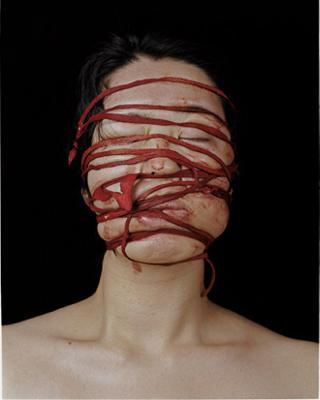I had the privilege of attending and navigating through a ground breaking exhibition, Global Feminisms, New Directions in Contemporary Art, showcasing feminists artists from across the globe, a plurality of feminine voices, in celebration of the opening of the Elizabeth A. Sackler for Feminist Art at the Brooklyn Museum in 2007. 80 women artist displaying works in all media-painting, sculpture, photography, film, video, installation, and performance. The dominate voice of feminist art from the Western world is leveled by the diverse voices of women artists from Africa, the East, Central America and more.

Tokyo Museum of Photography
The photograph “Bind”(2001) by Japanese artist Ryoko Suzuki is one of the evocative works in the exhibition. Suzuki wraps her head with tightly wound pigskin that has been soaked in blood. “Pigskin refers to the artist’s childhood memories of the story “Three Little Pigs” and blood symbolizes female sexuality.” Suzuki says Bind expresses her inner self; a symbol of womanhood, the transformation from a child “who just took what adults provided, to a woman who led her own life.”
This is a universal theme for many female youths evolving into womanhood—the desire to lead her own life. What is compelling is Suzuki’s actions, the act of binding her face, the way the skin distorts her facial features, “binds” her speech, her sight.
What does “Bind” represent to you? A woman, perhaps castrated by her culture? Does the photograph offer an entry way in which Suzuki can come into her own?
